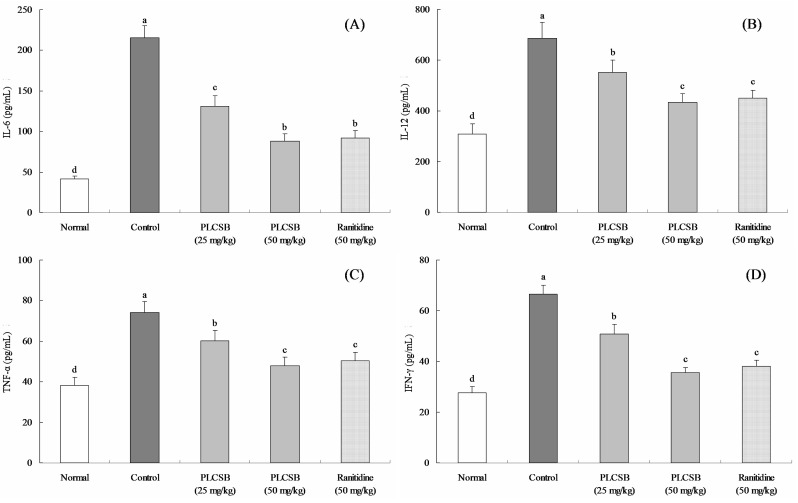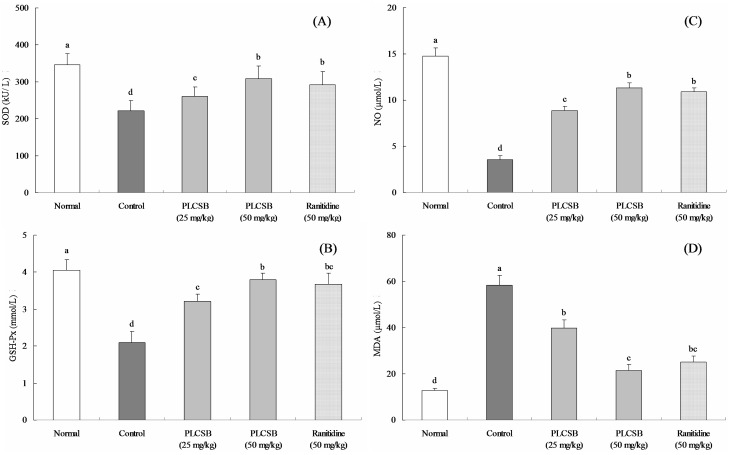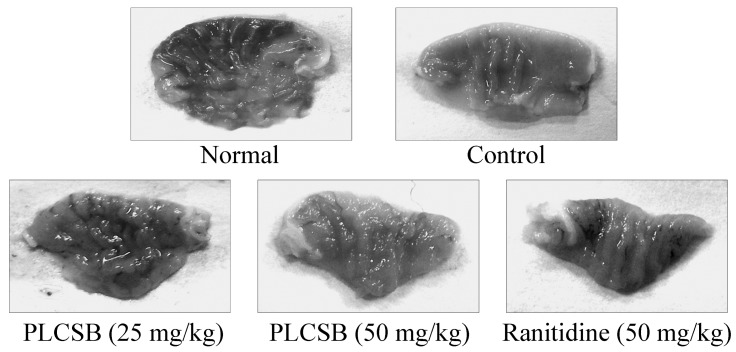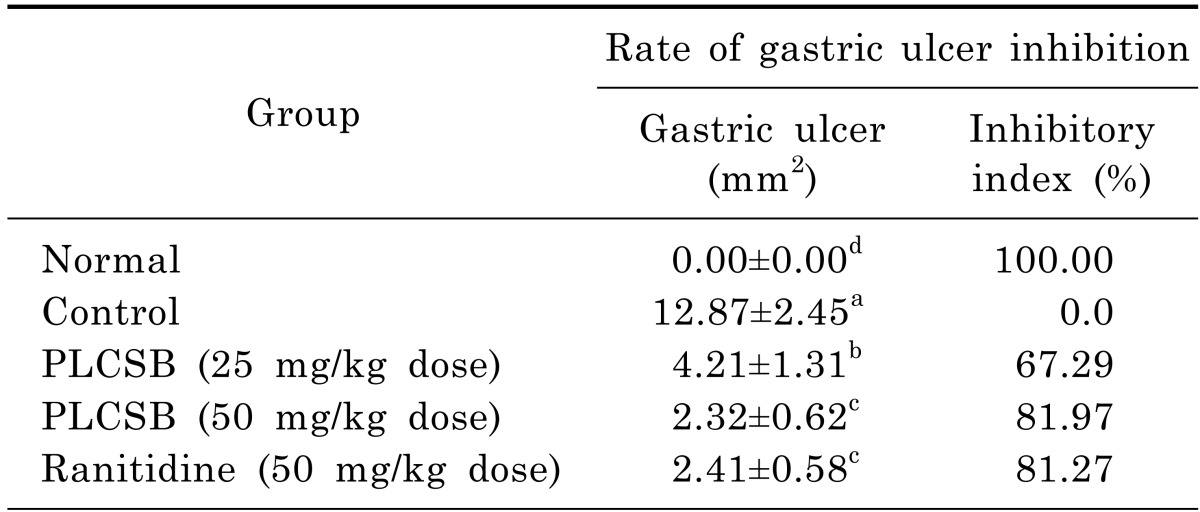1. Jian JC, Wu ZH. Effects of traditional Chinese medicine on nonspecific immunity and disease resistance of large yellow croaker. Pseudosciaena crocea (Richardson). Aquaculture. 2003; 218:1–9.
2. Li C, Yao CL. Molecular and expression characterizations of interleukin-8 gene in large yellow croaker (Larimichthys crocea). Fish Shellfish Immunol. 2013; 34:799–809. PMID:
23333360.
3. Liu S, Yu B. Peptides from variegated carp (aristichthys nobilis) swim bladder: fermentation production and assessment of antioxidant properties. Food Sci. 2009; 30:332–334.
4. Yu ZH, Yin LH, Yang Q, Liu Y. Effect of Lentinus edodes polysaccharide on oxidative stress, immunity activity and oral ulceration of rats stimulated by phenol. Carbohydr Polym. 2009; 75:115–118.

5. Laurienzo P. Marine polysaccharides in pharmaceutical applications: an overview. Mar Drugs. 2010; 8:2435–2465. PMID:
20948899.

6. Somasundaram S, Hayllar H, Rafi S, Wrigglesworth JM, Macpherson AJ, Bjarnason I. The biochemical basis of non-steroidal anti-inflammatory drug-induced damage to the gastrointestinal tract: a review and a hypothesis. Scand J Gastroenterol. 1995; 30:289–299. PMID:
7610343.
7. Baumeister AA, Hawkins MF, Uzelac SM. The myth of reserpine-induced depression: role in the historical development of the monoamine hypothesis. J Hist Neurosci. 2003; 12:207–220. PMID:
12953623.

8. Davies DL, Shepherd M. Reserpine in the treatment of anxious and depressed patients. Lancet. 1955; 269:117–120. PMID:
14392947.

9. Lemieux G, Davignon A, Genest J. Depressive states during Rauwolfia therapy for arterial hypertension; a report of 30 cases. Can Med Assoc J. 1956; 74:522–526. PMID:
13304797.
10. Yan C, Yan X. Study on extraction of Lycium barbarum polysaccharides by different methods and their antioxidant effects in vitro. Food Sci. 2008; 29:183–187.
11. Qu XZ, Jin GZ. Effects of the artemisinin on gastric ulcer induced by ethanol and reserpine in mice. J Med Sci Yanbian Univ. 2010; 33:96–97.
12. Wang Q, Zhao X, Qian Y, Wang R. In vitro antioxidative activity of yellow tea and its in vivo preventive effect on gastric injury. Exp Ther Med. 2013; 6:423–426. PMID:
24137202.

13. Kim KC, Lee CH. Reversal of Cisplatin resistance by epigallocatechin gallate is mediated by downregulation of Axl and Tyro 3 expression in human lung cancer cells. Korean J Physiol Pharmacol. 2014; 18:61–66. PMID:
24634598.

14. Xia AZ, Xue Z, Wang W, Zhang T, Wei TT, Sha XZ, Ding YX, Zhou WD. Naloxone postconditioning alleviates rat myocardial ischemia reperfusion injury by inhibiting JNK activity. Korean J Physiol Pharmacol. 2014; 18:67–72. PMID:
24634599.

15. Cao H, Tian XL, Liu X. Study on molecular identification and pharmacology of hemostasis action for isinglass. J Chin Inst Food Sci Technol. 2009; 9:170–176.
16. Ligumsky M, Sestieri M, Okon E, Ginsburg I. Antioxidants inhibit ethanol-induced gastric injury in the rat. Role of manganese, glycine, and carotene. Scand J Gastroenterol. 1995; 30:854–860. PMID:
8578183.

17. Gratacós J, Collado A, Filella X, Sanmartí R, Cañete J, Llena J, Molina R, Ballesta A, Muñoz-Gómez J. Serum cytokines (IL-6, TNF-alpha, IL-1 beta and IFN-gamma) in ankylosing spondylitis: a close correlation between serum IL-6 and disease activity and severity. Br J Rheumatol. 1994; 33:927–931. PMID:
7921752.
18. Fox JG, Beck P, Dangler CA, Whary MT, Wang TC, Shi HN, Nagler-Anderson C. Concurrent enteric helminth infection modulates inflammation and gastric immune responses and reduces helicobacter-induced gastric atrophy. Nat Med. 2000; 6:536–542. PMID:
10802709.

19. D'Elios MM, Manghetti M, De Carli M, Costa F, Baldari CT, Burroni D, Telford JL, Romagnani S, Del Prete G. T helper 1 effector cells specific for Helicobacter pylori in the gastric antrum of patients with peptic ulcer disease. J Immunol. 1997; 158:962–967. PMID:
8993017.
20. Ferguson-Smith AC, Chen YF, Newman MS, May LT, Sehgal PB, Ruddle FH. Regional localization of the interferon-beta 2/B-cell stimulatory factor 2/hepatocyte stimulating factor gene to human chromosome 7p15-p21. Genomics. 1988; 2:203–208. PMID:
3294161.
21. van der Poll T, Keogh CV, Guirao X, Buurman WA, Kopf M, Lowry SF. Interleukin-6 gene-deficient mice show impaired defense against pneumococcal pneumonia. J Infect Dis. 1997; 176:439–444. PMID:
9237710.

22. Engel MA, Neurath MF. Anticancer properties of the IL-12 family--focus on colorectal cancer. Curr Med Chem. 2010; 17:3303–3308. PMID:
20712574.
23. Gosselin D, Rivest S. Role of IL-1 and TNF in the brain: twenty years of progress on a Dr. Jekyll/Mr. Hyde duality of the innate immune system. Brain Behav Immun. 2007; 21:281–289. PMID:
17275255.

24. Abdollahi H, Shams S, Zahedi MJ, Darvish Moghadam S, Hayatbakhsh MM, Jafarzadeh A. IL-10, TNF-α and IFN-γ levels in serum and stomach mucosa of Helicobacter pylori-infected patients. Iran J Allergy Asthma Immunol. 2011; 10:267–271. PMID:
22184269.
25. Gislason H, Røkke O, Svanes K. Release of cytokines associated with gastric mucosal injury. Eur Surg Res. 1996; 28:278–286. PMID:
8813652.

26. Kuzuhara T, Suganuma M, Oka K, Fujiki H. DNA-binding activity of TNF-alpha inducing protein from Helicobacter pylori. Biochem Biophys Res Commun. 2007; 362:805–810. PMID:
17765875.
27. Wang HY, Liu YM, Li HY, Feng QJ, Guo JY, Niu X. Effects of oils in alpinia officinarum hance on serum motilin, somatostatin, substance P, vasoactive intestinal peptide in gastrelcosis mice model. Chin J Exp Tradit Med Formulae. 2011; 17:105–107.
28. Zhang SR, Shao JY, Yu YW. The protective effects of furazolidone and some commonly used anti-ulcer drugs on several gastric ulcer models in rats. Yao Xue Xue Bao. 1984; 19:5–11. PMID:
6464767.
29. Zhao X, Wang Q, Qian Y, Song JL.
Ilex kudingcha C.J. Tseng (Kudingcha) prevents HCl/ethanol induced gastric injury in Sprague Dawley rats. Mol Med Rep. 2013; 7:1613–1616. PMID:
23546392.
30. Qu CY, Li DG, Wang YQ, Chen MM. Effect of chitosan on the serum levels of MDA,SOD,and GSH-Px in rats with gastric ulcer in high altitude region. Shanghai Med Pharm J. 2008; 29:219–222.
31. Cheng HH, A XR. Change of serum nitrogen monoxidum and nitrogen monoxidum synthase levels in patients with peptic ulcer. Lab Med. 2010; 25:427–428.
32. Wang G, Tu ZL, Chen L, Yuan SH, Yang GY. Mechanism of anti-ulcer effects of Jinguolan. Herald Med. 2009; 28:42–45.
33. Baeuerle PA. IkappaB-NF-kappaB structures: at the interface of inflammation control. Cell. 1998; 95:729–731. PMID:
9865689.
34. Sánchez-Pérez I, Benitah SA, Martínez-Gomariz M, Lacal JC, Perona R. Cell stress and MEKK1-mediated c-Jun activation modulate NFkappaB activity and cell viability. Mol Biol Cell. 2002; 13:2933–2945. PMID:
12181357.
35. Li HL, Sun BZ, Ma FC. Expression of COX-2, iNOS, p53 and Ki-67 in gastric mucosa-associated lymphoid tissue lymphoma. World J Gastroenterol. 2004; 10:1862–1866. PMID:
15222024.

36. Hayden MS, Ghosh S. Signaling to NF-kappaB. Genes Dev. 2004; 18:2195–2224. PMID:
15371334.
37. Kim SF, Huri DA, Snyder SH. Inducible nitric oxide synthase binds, S-nitrosylates, and activates cyclooxygenase-2. Science. 2005; 310:1966–1970. PMID:
16373578.

38. Chen LH, Song JL, Qian Y, Zhao X, Suo HY, Li J. Increased preventive effect on colon carcinogenesis by use of resistant starch (RS3) as the carrier for polysaccharide of
Larimichthys crocea swimming bladder. Int J Mol Sci. 2014; 15:817–829. PMID:
24413751.







 PDF
PDF ePub
ePub Citation
Citation Print
Print






 XML Download
XML Download